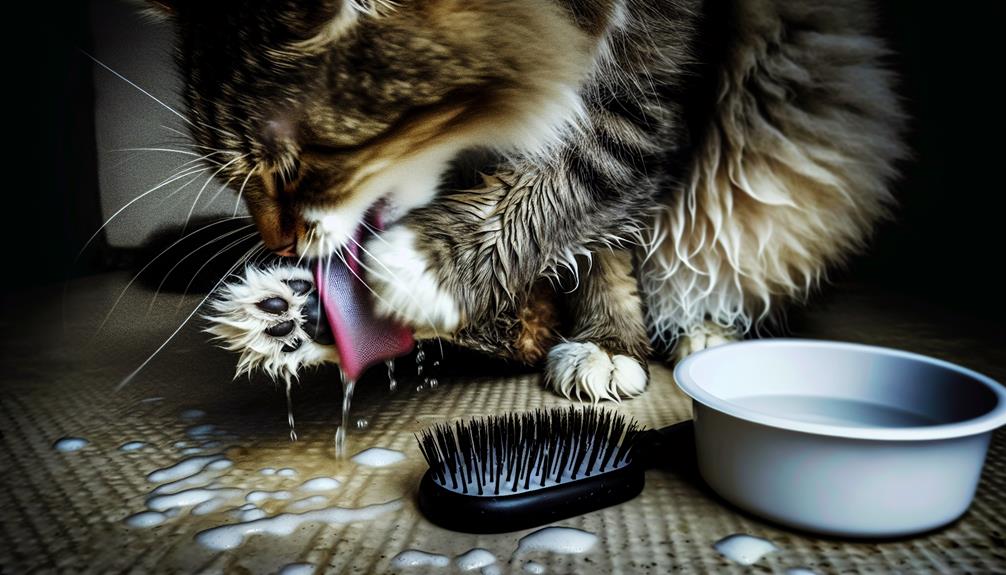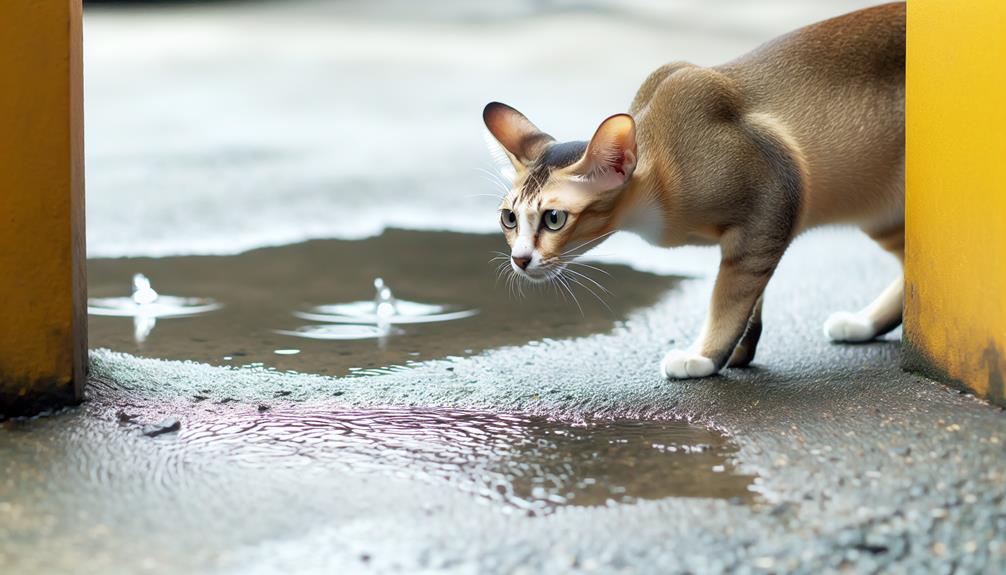Imagine a cat as a meticulously crafted piece of art, each stroke of fur and whisker placed with purpose, unspoiled by the chaos of water. You might wonder why your feline friend recoils at the sight of a bath or a splash. It's not just about being finicky; there's a blend of evolutionary history and sensory sensitivities at play. Their ancestors thrived in arid climates, making water a rare and often unwelcome element. But there's more to uncover about their grooming habits and the impact of negative experiences that lead to their notorious aversion.
Evolutionary Background
From an evolutionary perspective, cats' aversion to water can be traced back to their origins as desert-dwelling animals. Feline ancestors thrived in arid environments where water bodies were scarce. Consequently, these wild habitats did not necessitate the development of aquatic survival skills. The primary focus of survival adaptations was on hunting strategies and territorial instincts, rather than water navigation.
Considering the coat structure of felines, it's evident that their fur is not optimized for prolonged exposure to water. Unlike aquatic mammals, whose dense undercoats provide insulation and buoyancy, a cat's fur absorbs water, becoming heavy and cumbersome. This hinders their agility, a critical component of their hunting strategies. Therefore, the evolutionary traits of feline ancestors favored a dry environment to maintain the efficiency of their predatory skills.
Additionally, territorial instincts play a significant role in a cat's behavioral repertoire. Cats mark their territories using scent glands located on their faces and bodies. Water can wash away these scent markers, disrupting their ability to communicate and establish dominance within their territory. This further reinforces their natural aversion to water.
In terms of evolutionary traits, cats developed a keen sense of balance and agility suited for land-based hunting. Their retractable claws and flexible bodies are designed for climbing and pouncing, not swimming. Thus, their evolutionary background shaped a preference for dry conditions, aligning with their survival adaptations.
Sensory Sensitivities
Understanding cats' evolutionary background sheds light on their inherent preference for dry conditions. One significant aspect is their acute sensory sensitivities. When a cat's fur becomes wet, it can cause discomfort due to the change in texture and additional weight. Wet fur can take a considerable time to dry, leading to a prolonged period of unease for the feline. This is a stark contrast to their typically lightweight, dry coat, which they meticulously maintain.
Sensory overload is another critical factor. Cats possess highly sensitive nerve endings in their skin, making them extremely perceptive to changes in their environment. When exposed to water, these nerve endings can become overstimulated, resulting in a sensory overload. This discomfort can manifest in various behavioral responses, such as frantic attempts to escape or excessive grooming to remove the moisture.
Furthermore, water play is not instinctual behavior for most cats. Unlike some animals that have evolved to thrive in aquatic environments, cats' evolutionary history has largely involved dry, arid regions. Consequently, they haven't developed the same affinity for water. Environmental factors, such as the availability of hydration sources, have historically shaped feline instincts. Cats in the wild often derive moisture from their prey, negating the need for direct water interaction.
Grooming Habits

Grooming habits in cats are an intricate and essential aspect of their behavior, driven by a combination of instinct and necessity. Cats utilize advanced grooming techniques to maintain fur integrity and overall hygiene. You'll notice that they spend a considerable amount of time self-cleaning, a practice critical for fur maintenance and skin health. This meticulous grooming involves the use of their rough tongues, which are adept at removing dirt, loose hair, and parasites.
Cats' water avoidance can be partly explained by their grooming rituals. Unlike humans, who may rely on water for cleanliness, cats have evolved to keep their coats in prime condition without it. Their saliva contains enzymes that break down debris and oils, contributing to efficient coat conditioning. This methodical approach to grooming helps in preserving the natural oils that keep their fur waterproof and insulated.
Cats' hygiene practices are so effective that you might rarely need to bathe them. Their grooming techniques are designed to address most hygiene needs without the introduction of water, which they often find uncomfortable due to their finely-tuned balance and temperature regulation mechanisms. Waterlogged fur can become heavy and impede a cat's mobility, adding another layer of reasoning behind their water avoidance.
In addition to fur maintenance, regular grooming also plays a role in thermoregulation and social bonding. Mutual grooming or "allogrooming" among cats not only reinforces social structures but also guarantees that hard-to-reach areas are adequately cleaned. Consequently, their grooming habits are a sophisticated blend of self-care, social interaction, and evolutionary adaptation, making water largely unnecessary in their hygiene repertoire.
Temperature Preferences
Cats' meticulous grooming habits guarantee their fur remains clean and functional without the need for water, highlighting their distinct temperature preferences. Unlike humans, cats have evolved to maintain their body temperature through behaviors and physiological mechanisms that do not rely on water immersion. Understanding these temperature ranges and thermal regulation methods can offer insight into why your cat might avoid water at all costs.
Cats are naturally predisposed to environments with moderate and stable temperatures. Their ideal comfort zone typically falls between 86°F to 97°F (30°C to 36°C). In these conditions, they can efficiently regulate their body temperature without additional cooling methods such as swimming or bathing. Water, especially if it's cold, can drastically lower their body temperature, leading to discomfort or even hypothermia in extreme cases.
The following table outlines the preferred temperature ranges for various feline activities:
| Activity | Preferred Temperature Range |
|---|---|
| Resting | 86°F – 97°F (30°C – 36°C) |
| Active Play | 75°F – 86°F (24°C – 30°C) |
| Sleeping | 86°F – 97°F (30°C – 36°C) |
| Eating | 75°F – 86°F (24°C – 30°C) |
Cats rely on their fur for thermal regulation, which serves as both insulation against the cold and a barrier against heat. When a cat's fur gets wet, it loses its ability to insulate properly, disrupting the cat's thermal balance. This explains why even a small amount of water can make a cat extremely uncomfortable. Essentially, their thermal regulation strategies are finely tuned to avoid the need for water-based cooling, and as a result, this reinforces their aversion to it.
Lack of Exposure

You've likely noticed that a cat's early life habits greatly influence its behavior towards water. If a cat experiences limited water interactions during its formative months, it generally develops an aversion due to unfamiliarity. This lack of exposure during critical periods of socialization can result in a persistent reluctance to engage with water.
Early Life Habits
A significant factor in a cat's aversion to water often stems from its early life habits, particularly the lack of exposure to aquatic environments during formative stages. During kitten development, the experiences and behavioral conditioning provided by the mother cat play a considerable role. Maternal influences are essential; if the mother cat exhibits a strong aversion to water, she may inadvertently transfer this behavior to her offspring.
In the neonatal and socialization periods, which are critical phases of kitten development, exposure to various stimuli—including water—is essential. However, in many domestic settings, kittens rarely encounter water in a context that promotes positive associations. This absence of early, controlled exposure to water can lead to heightened neophobia, a fear of new things, in adult cats.
Furthermore, the tactile and sensory experiences during these critical periods shape a kitten's long-term behavioral responses. If a kitten's initial interactions with water are stressful or negative, the aversion is likely to be reinforced. Therefore, the lack of early, positive exposure to water coupled with maternal influences considerably contributes to the persistent aversion many cats exhibit towards water throughout their lives.
Limited Water Experiences
Exposure to water during a cat's developmental stages plays an essential role in shaping its behavioral responses. Cats that lack early water play experiences are less likely to develop comfort around water as adults. Unlike aquatic species, which are naturally conditioned to interact with water, domestic cats often have limited exposure during significant periods of socialization.
When kittens aren't introduced to water play, they miss out on forming positive associations with water. This lack of exposure can result in heightened stress and anxiety when they encounter water later in life. Additionally, the absence of gradual acclimatization to water can exacerbate their innate reluctance, rooted in evolutionary traits designed to avoid unnecessary risks.
From a clinical perspective, it's evident that early environmental enrichment, including controlled water play, is vital for mitigating water aversion. Behavioral conditioning during the sensitive developmental window can desensitize cats to water, though it's often an overlooked aspect of feline care. Consequently, most domestic cats retain a behavioral predisposition to avoid water, unlike their aquatic counterparts.
Negative Experiences
Cats' aversion to water can often be traced to negative experiences, which may include traumatic events or distressing incidents involving water. These negative associations contribute greatly to a cat's behavior, as traumatic encounters can lead to long-lasting fear factors. Such experiences trigger instinctual reactions and stress responses, making the mere sight of water a source of anxiety.
Behavioral conditioning plays a vital role in shaping these aversions. When cats encounter water under distressing circumstances, their brains associate the substance with fear and discomfort. Over time, even the sound of running water can cause anxiety. This is due to past incidents, where water may have been involved in scaring the cat or causing physical discomfort. For example:
- Accidental Submersion: A cat accidentally falling into a bathtub or pool can lead to a panic response, reinforcing negative associations with water.
- Forced Baths: Being held and washed against their will can be a traumatic experience, heightening their aversion.
- Noisy Environments: Loud noises from running water or splashing can be alarming, adding to their stress responses.
- Injury or Discomfort: Past incidents where water caused pain or irritation, such as shampoo stinging their eyes, can create lasting fear factors.
Territorial instincts also play a part. Cats are highly territorial animals, and water can feel like an invasion of their personal space. When their territory is disrupted by an unwanted substance, it provokes an instinctual reaction to avoid it at all costs. Understanding these negative experiences helps explain why many cats develop a profound dislike for water and helps in developing strategies to mitigate their stress.
Health Concerns

Health concerns are another critical factor contributing to a cat's aversion to water. Cats are highly sensitive creatures, and immersion in water can exacerbate various health risks. One primary concern is their hydration needs. Unlike dogs, cats do not have a strong drive to drink water, which means excessive exposure to water can disrupt their delicate hydration balance, potentially leading to dehydration.
Skin issues are also a significant consideration. Cats possess a unique pH balance on their skin, which acts as a natural barrier against pathogens. Frequent exposure to water can strip away essential oils, leading to dry, flaky skin and increased susceptibility to infections. This disruption can further complicate efforts in parasite prevention, as a compromised skin barrier is more prone to infestations by fleas, mites, and other parasites.
Behavioral health is another aspect that can't be overlooked. Cats are creatures of habit and any deviation from their routine can be a substantial stress factor. Being forced into water can trigger anxiety and stress, impacting their overall well-being. Stress factors can manifest in various ways, including changes in appetite, grooming habits, and even litter box usage.
Furthermore, the stress induced by water exposure can have long-term repercussions on a cat's behavioral health. Chronic stress can weaken the immune system, making the cat more vulnerable to illnesses. This underscores the importance of minimizing unnecessary water exposure to safeguard both their physical and mental health.
Conclusion
To summarize, understanding why cats don't like water requires examining their evolutionary background, sensory sensitivities, grooming habits, and temperature preferences. Limited exposure and negative experiences exacerbate their aversion. The theory positing their desert-dwelling origins as a primary factor holds substantial merit, given their physiological adaptations. Sensory overload from water exposure furthers this aversion, aligning with their finely tuned grooming habits and skin sensitivities. Consequently, cats' water aversion is a multifaceted issue rooted in both evolutionary and behavioral factors.
